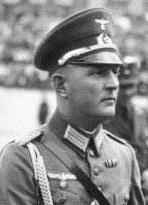| This article needs additional citations for verification. Please help improve this article by adding citations to reliable sources. Unsourced material may be challenged and removed. Find sources: "Friedrich Hossbach" – news · newspapers · books · scholar · JSTOR (October 2012) (Learn how and when to remove this message) |
| Friedrich Hossbach | |
|---|---|
 Hossbach in 1934 Hossbach in 1934 | |
| Born | (1894-11-22)22 November 1894 Unna, German Empire |
| Died | 10 September 1980(1980-09-10) (aged 85) Göttingen, West Germany |
| Allegiance | |
| Service | |
| Years of service | 1913–45 |
| Rank | General of the Infantry |
| Commands | 82nd Infantry Division LVI Panzer Corps 4th Army |
| Battles / wars | World War I World War II |
| Awards | Knight's Cross of the Iron Cross with Oak Leaves |
Friedrich Hossbach (22 November 1894 – 10 September 1980) was a German staff officer in the Wehrmacht who in 1937 was the military adjutant to Adolf Hitler. Hossbach created the document that later became known as the Hossbach Memorandum.
Career
Hossbach created the document that later became known as the Hossbach Memorandum, a report of a meeting held on 5 November 1937 between Hitler and Feldmarschall Werner von Blomberg, General Werner von Fritsch, Admiral Erich Raeder, Generaloberst Hermann Göring, Baron Konstantin von Neurath and Hossbach. The account of Hossbach was found among the Nuremberg papers, where it was an important piece of evidence.
In early 1938, Hossbach was present when Hitler was presented by Goering with a file purporting to show that General von Fritsch, the commander-in-chief of the Army, was guilty of homosexual practices. In defiance of Hitler's orders, Hossbach took the file to Fritsch to warn him of the accusations that he was about to face. Fritsch gave his word as an officer that the charges were untrue, and Hossbach passed that message back to Hitler. That did not, as it might have, cost Hossbach his life, but he was dismissed from his post as Hitler's adjutant two days later.
Hossbach was restored to the general staff in 1939 and promoted to major general on 1 March 1942. Exactly five months later, he was promoted again to lieutenant general, and his last promotion occurred on 1 November 1943, when he became general of infantry and was given command of the 56th Panzer Corps. He spent the next two years on the Eastern Front. He took over as commander of the 4th Army on 28 January 1945 but was dismissed two days later for defying Hitler's orders and withdrawing his troops from East Prussia in fear of a second Stalingrad.
Awards
- Iron Cross (1914) 2nd Class (26 September 1914) & 1st Class (26 May 1916)
- Clasp to the Iron Cross (1939) 2nd Class (11 May 1940) and 1st Class (30 May 1940)
- Honour Roll Clasp of the Army (22 July 1941)
- Knight's Cross of the Iron Cross with Oak Leaves
- Knight's Cross on 7 October 1940 as Oberst and commander of Infanterie-Regiment 82
- Oak Leaves on 11 September 1943 as Generalleutnant and acting commander of LVI. Panzerkorps
References
Citations
- Documents of German Foreign Policy, I, pp. 29-39
- William Shirer, The Rise and Fall of the Third Reich p. 315
- Who's who in Nazi Germany p. 126
- ^ Thomas 1997, p. 302.
Bibliography
- Jones, Michael (2011) "Total War. From Stalingrad to Berlin". John Murray, London. ISBN 978 1 8485 4231 0
- Fellgiebel, Walther-Peer (2000) . Die Träger des Ritterkreuzes des Eisernen Kreuzes 1939–1945 — Die Inhaber der höchsten Auszeichnung des Zweiten Weltkrieges aller Wehrmachtteile [The Bearers of the Knight's Cross of the Iron Cross 1939–1945 — The Owners of the Highest Award of the Second World War of all Wehrmacht Branches] (in German). Friedberg, Germany: Podzun-Pallas. ISBN 978-3-7909-0284-6.
- Thomas, Franz (1997). Die Eichenlaubträger 1939–1945 Band 1: A–K [The Oak Leaves Bearers 1939–1945 Volume 1: A–K] (in German). Osnabrück, Germany: Biblio-Verlag. ISBN 978-3-7648-2299-6.
- Who's Who in Nazi Germany. Routledge, 1995. ISBN 0-415-12723-8
| Military offices | ||
|---|---|---|
| Preceded byGeneralmajor Gerhard Berthold | Commander of 31. Infanterie-Division 20 January 1942 – 24 February 1942 |
Succeeded byGeneralleutnant Kurt Pflieger |
| Preceded byGeneralleutnant Josef Lehmann | Commander of 82. Infanterie-Division 1 April 1942 – 6 July 1942 |
Succeeded byGeneralleutnant Alfred Bäntsch |
| Preceded byOberst Hermann Flörke | Commander of 31. Infanterie-Division 15 May 1943 – 2 August 1943 |
Succeeded byOberst Kurt Moehring |
| Preceded byGeneral der Panzertruppe Ferdinand Schaal | Commander of LVI Panzer Corps 1 August 1943 – 14 November 1943 |
Succeeded byGeneral der Infanterie Anton Grasser |
| Preceded byGeneral der Infanterie Anton Grasser | Commander of LVI Panzer Corps 9 December 1943 – 14 June 1944 |
Succeeded byGeneral der Infanterie Johannes Block |
| Preceded byGeneral der Infanterie Kurt von Tippelskirch | Commander of 4. Armee 18 July 1944 – 29 January 1945 |
Succeeded byGeneral der Infanterie Friedrich-Wilhelm Müller |
| Knight's Cross of the Iron Cross recipients of the 31st Infantry Division | |
|---|---|
| |
| Oak Leaves with LVI Panzer Corps |
 Media from Commons
Media from Commons